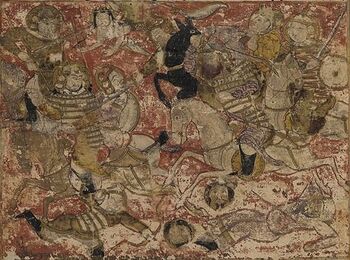عنف طائفي
العنف الطائفي Sectarian violence أو الفتنة الطائفية ، هي العنف الذي ينشأ بسبب الطائفية ، أي بين فروع مختلفة في نمط معين من التفكير ، وليس من الضروري أن ترتبط الفتنة الطائفية بالدين فهناك فتن طائفية بسبب الاختلاف السياسية (مثل الصراعات التي كانت بين الشيوعيين والقوميين في الصين في أوائل القرن العشرين وقد بدأها القوميون الصينيون في ذلك الوقت كفتنة طائفية). وتضمن الأسباب المؤدية للفتنة الطائفية صراعات القوى ، المناخ السياسي ، الاجتماعي ، الثقافي ، والظروف الاقتصادية. [1]
- الرأسمالية و collectivism الاقتصادية.
- الشيوعية والقومية السياسية.
- المسيحية - الكاثوليكية والپروتستانتية.
- الإسلام - السنة والشيعة.
. . . . . . . . . . . . . . . . . . . . . . . . . . . . . . . . . . . . . . . . . . . . . . . . . . . . . . . . . . . . . . . . . . . . . . . . . . . . . . . . . . . . . . . . . . . . . . . . . . . . . . . . . . . . . . . . . . . . . . . . . . . . . . . . . . . . . . . . . . . . . . . . . . . . . . . . . . . . . . . . . . . . . . . .
أيرلندا الشمالية
اسكتلندا
الصراعات بين السنة والشيعة
Sectarian violence between the two major sects of Islam, Shia and Sunni, has occurred in countries like Pakistan, Iraq, Afghanistan, Bahrain, Lebanon etc. This violent conflict has roots in the political turmoil arising out of differences over the succession to Muhammad. Abu Bakr, a companion of Muhammad, was nominated by Umar and elected as the first Sunni Rightly Guided Caliph. However another group felt that Ali, the cousin and son-in-law of Muhammad, had been designated by Muhammad and is considered by Shia as the first Imam.
According to Sunnis, Abu Bakr was followed by Umar as caliph of the Rashidun Caliphate, then by Uthman ibn Affan and finally by Ali. Ali's right to rule was challenged by Muawiyah bin Abu Sufian, governor of Syria, who believed[بحاجة لمصدر] that Ali should have acted faster against the murderers of Uthman. The situation deteriorated further when many of those responsible for the death of Uthman rallied behind Ali. However, later on, both the parties agreed to have some one as a judge between them. This led to the separation of an extremist group known as Kharijites from Ali's army, which pronounced the judgement belonged to God alone. A member of this group later assassinated Ali. By breaching, Hasan-Muawiyah Treaty, Muawiyah appointed his son Yazid as his successor. The credentials and rule of Yazid were challenged by Ali's son Hussein ibn Ali (and grandson of Muhammad). A battle at Karbala in Iraq led to the martyrdom of Hussein and dozens of others from Ahl al-Bayt (the members of the family of Muhammad).[بحاجة لمصدر]
This tragic incident created deep fissures in the Muslim society. The conflict that had started at a political plane intervened with the dogma and belief systems.[بحاجة لمصدر] Those who consider Ali to be the true heir to the Muhammad are known as "Shia" referring to Shian-e-Ali. The other Muslims are known as "Sunni" meaning "followers of the Traditions of The Prophet".[بحاجة لمصدر]
في العراق
In February 2006, a full-scale civil war erupted in Iraq, when violence between the two Muslim rival sects erupted. It has left tens of thousands to hundred thousands of people dead and dozens of mosques and homes destroyed.[2]
في پاكستان
In Pakistan sectarianism exhibited its first organized nature in early 1980 when two rival organizations were established: Tehrik-e-Jafaria (TFJ) (Organization of the Jafri (Shia) Law) represented Shia communities, and Sipah-e-Sahaba Pakistan (SSP) (Guardian of the Companions of the Prophet) representing Sunnis. The first major incident of this sectarian violence was killing of the Arif Hussain Hussaini, founding leader of TFJ in 1986.
In retaliation Haq Nawaz Jhangvi, founder of the (SSP) was murdered. Since then internecine bloody vendetta has ensued. The focus of this violence has been Kurram, Hangu, Dera Ismail Khan, Bahawalpur, Jhang, Quetta,Gigit- Baltistan and Karachi.
The transformation of the sectarian conflict to a violent civil war in Pakistan coincided[بحاجة لمصدر] with the establishment of the Islamic republic in Iran and promotion of the Sunni religion and its incorporation in the state institutions by General Muhammad Zia-ul-Haq, regime in Pakistan.
The Iranian Revolution was led by Shia clerics, and it influenced Shia communities all over the world. In Pakistan Tehrik-e-Jafaria was established with the demands of enforcing the Sharia Law.[بحاجة لمصدر] This demand was viewed as detrimental by the Sunni religious leaders. In response SSP was established by the Sunni extremist clerics. Many of these clerics had a background in the sectarian strife against the Ahmadis (a heterodox sect considered non-Muslim by majority of the Muslims)
في الصومال
Ahlu Sunna Waljama'a is a Somali paramilitary group consisting of Sufis and moderates opposed to the radical Islamist group Al-Shabaab. They are fighting in order to prevent Wahhabism from being imposed on Somalia and to protect the country's Sunni-Sufi traditions and generally moderate religious views.[3]
في سوريا
The Syrian civil war gradually shifted towards a more sectarian nature. Pro-Assad militant groups are largely[بحاجة لمصدر] Shia, while anti-Assad militant groups are non-secular, fundamentalist Sunni.
في اليمن
In Yemen, there have been many clashes between Salafis and Shia Houthis.[4] According to The Washington Post, "In today’s Middle East, activated sectarianism affects the political cost of alliances, making them easier between co-religionists. That helps explain why Sunni-majority states are lining up against Iran, Iraq and Hezbollah over Yemen."[5]
انظر أيضاً
أمثلة
- La Violencia in Colombia
- Communalism (South Asia)
- Cypriot intercommunal violence
- Religious violence in India
- 2005 civil unrest in France
- 2005 Cronulla riots
- 2006 Brussels riots
- 2009 Boko Haram Uprising
- 2009 Gojra riots
- Rohingya conflict
المصادر
- ^ / ويكيبديا الانجليزية
- ^ Finer, Jonathan; Sebti, Bassam (24 February 2006). "Sectarian Violence Kills Over 100 in Iraq". The Washington Post.
- ^ "Somali rage at grave desecration". BBC News. 8 June 2009.
- ^ Salafi-Houthi clashes in Yemen kill 14 Archived 22 يناير 2012 at the Wayback Machine retrieved 6 February 2012
- ^ "How sectarianism shapes Yemen's war". The Washington Post. 13 April 2015.

